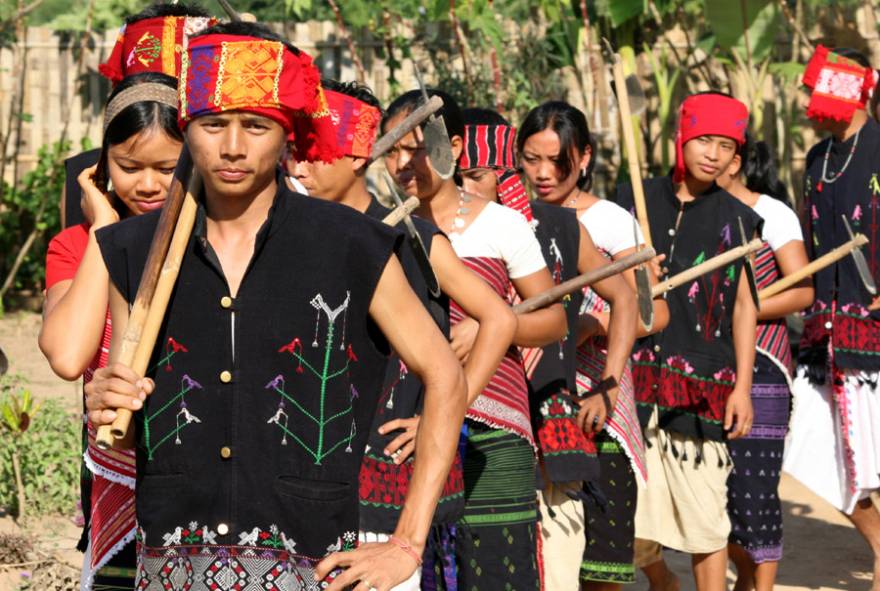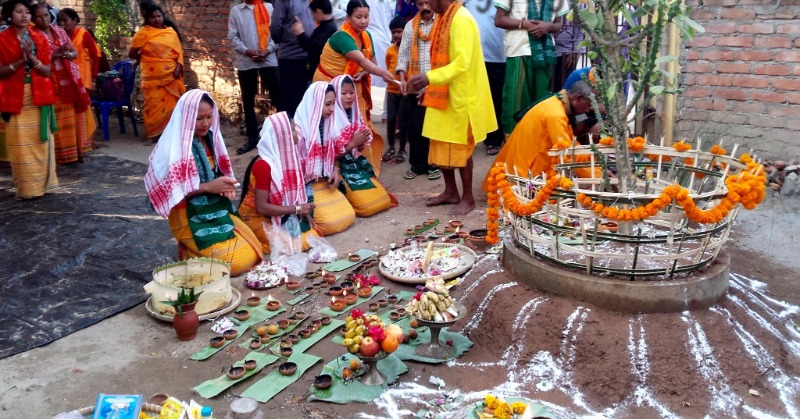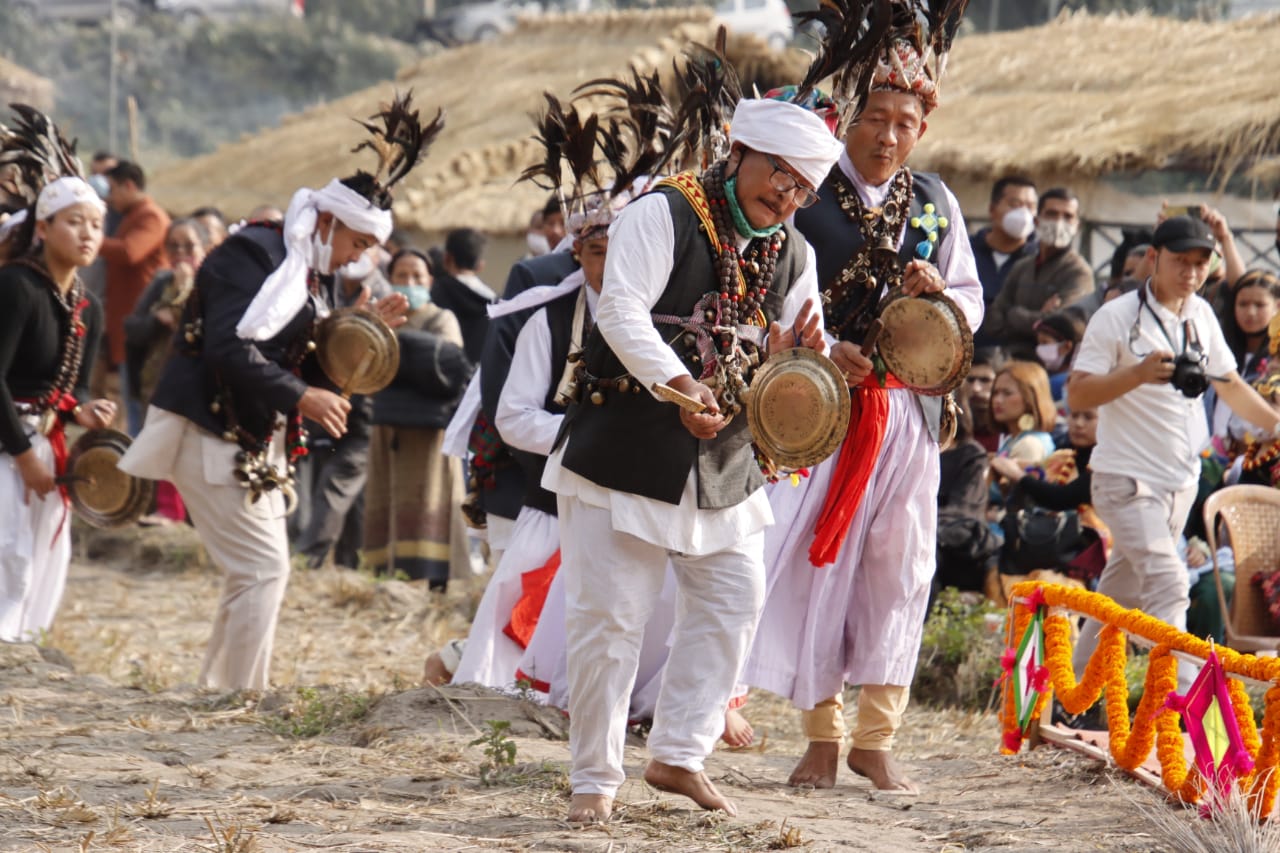By Dhaneswar Engti
INTRODUCTION
According some eminent historians, Karbis racially belong to the Mongoloid family and linguistically belong to the Tibeto-Burmon group. According to Stack and Lyall – “the name Mikir is given to the race by the Assamese, its origin is unknown.” However, the Karbis never call themselves ‘Mikir’ but feel comfortable to call themselves ‘Karbi’ and sometimes ‘Arleng’ which literally means, - a man.
The Karbi culture has an organic blend of unity and diversity. Perhaps, it has happened due to its cultural movements that have taken place from time to time in Karbi society. It has brought about by its self-motivated character, believing cultural unity in diversity. It has shaped and moulded by different traditional faiths and cultural institutional heads since time immemorial in the Karbi Society. The Karbi culture, by its unique status and uniformity and unfailing vitality has been the most powerful determining dynamic force from the beginning of the Karbi history. This dynamic force of uniformity has brought about Karbi culture, the blends of unity and diversity. There is a special status of Karbi traditional culture and literature in the cultural heritage of the Karbi tribe.
The early Karbi tribe inherited a noteworthy literature of hymn and songs from their ancestors, like - Rangsina Sarpo, one of the greatest educators of Karbi folk culture and literature of the olden days. The ancestors might be the great Mongoloid family of the Tibeto-Burman or the Kuki Chin groups of people. Before that, it has also believed that the primitive Karbi Tribe has their home in the stiff land of Tibet. The hymns of the Karbis, i.e. A Hymn to the Origin of Karbis (Karbi Keplang), and, the description of the Karbis Ancestral Origin (Mosera Kehir); those were called “Porom Alun.” Their roots go back to the world of the primitive Karbi Society. Those were, generally found in the earliest available hymns and folk songs of the Karbis.
The hymns (Porom Alun), as used in the religious ceremonies of the Karbi society, were chanted with high esteem and the pronunciation of the words in sound and form as well as in the accent and the hymns had acquired a remarkable sanctity in them. The Priests (Kurusar) who studied the hymns, and chanted them after learning them by heart, were the ‘Hemphu’ and ‘Mukrang’, who were regarded as the direct descendents of divinities from the Heaven. They were dedicated to preserving the hymns through oral traditions. As custodians of these sacred cultural and religious heritages of the Karbis, - they were accorded respect and held highest social status in the Karbi society. Karbis are found to be one of the major and most indigenous and higly scattered communities, living in different parts of Karbi Anglong, Dima Hasao and almost the entire region of Assam, they are also found living in Arunachal Pradesh, Meghalaya, Nagaland, Monipur and other parts of the North-East India. They are the major Tribal community to hold a very distinctive character of culture and social order that can be exclusively studied and understood about its letter of credence and preservation of this interesting culture for use of the posterity in future. It is required for intensive research and investigation to understand more about the deeper meaning of the philosophy of this particular indigenous tribal faith and culture of the north-east India.
It is interesting to mention here that, the Karbis have their own form of 'Ramayana', and they like to call it - 'Sabin Alun', and the literal meaning of 'Sabin Alun' is - Songs of Sabin. This religious song was first sung by Longbi and Chedu in the holly court of Rukasen, one of the most wise King of Karbi Kingdom. Both Longbi and Chedu were the desciples of Mirjeng musoso, (Mirjeng Brothers), and they were the immediate desciples of great Rangsina Sarpo, the Guru and one of the greatest teachers of Karbi Folk Culture.
BIRTH RITUALS:
For the Karbis, the birth of a child whether male or female is an occasion of joy and happiness to celebrate by the immediate family members. They got to belief that – a person died earlier in the family is supposed to have born again in the same family. The Karbis also got to believe that – the birth of a child is the rebirth of a dead member of his family, and, it is a very fortunate moment for the family members that one of the dead members is born again as a human being in the same family circle.
It is essential to mention here that, when a baby is born to a Karbi family, then the new born baby must be ritually purified in order to avoid evil influences of bad spirits and this particular ritual is called – ‘Klongklo Athekar.’ However, even way before the birth of the baby, there is a ritual to be performed when the mother is five to six months pregnant, seeking for good health and blessings of the pregnant mother. After that a ritual to be perfomed when the baby is born, and this particular ritual is called - ‘Hemphu Avur Kematha’. It is required to perform for protection of both mother and the new born baby from the influences of evil spirits.
The Karbis maintain the concept of re-incarnation or rebirth of the deceased members of the same family. Thus, a person’s rebirth is possible within the same clan only. The naming of a new born child is a great occasion of celebration for the concerned family members. Generally, a white yarn is tied to the right wrist of a new born child as a part of naming ceremony in the Karbi society. They generally named the new born child after the names of the deceased persons of the same family or clan – like their great grandfather, grandfather, name of the father or brothers/sisters already expired long ago, and they got to believe that they are the rebirth of their deceased relatives. For a new born child, where the maternal uncle of the child takes the leading role, if the child is male one then it is the maternal uncle of the child to cut his hair first and it is done in a ritual ceremony. But for the girl child it is not necessary to do so. The naming of a girl child is given in accordance with the previous deceased women members of the same family. The concept of re-incarnation or rebirth is believed to have originated from the faith of immortality of soul of a man or woman according to the Karbi’s religious believes.
The Karbis practice exogamous marriage convention and maintain transparency of matrimony among the Karbi clans. As such, a Karbi male/female retains the surname of his/her father’s clan as per age old Karbi’s custom and traditions..
KARBI MARRIAGE LAWS:
In respect of marriage clan exogamy is strictly followed by the Karbis. The violation of this customary law leads to ex-communication or severe punishment as per Karbi customary laws; this marriage taboo is rarely violated by the Karbis even today.
In Karbi marriage rules, there is a close relationship of the kinship terminology with the Karbi matrimonial cross-cousin marriage system consisting of a man to marry his mother’s brother’s daughter. At every generation a man is advised to choose a girl from the same clan of his mother's. Such a regulatory rule of association unites a whole series of distinct clans or lineages of marriage on the basis of wife-taking and wife-giving correlationship. It was strickly followed during the olden days in the Karbi society.
In Karbi society, monogamy is the most popular and prevailing practice and there is no bar to polygamy and cases of polygamy are very rare to wtness in the Karbi’s marriage practices. Another important practice of marriage in the Karbi society is widow remarriage, the widow remarriage is a customary practice of Karbi society, and it is allowed by the Karbi customary laws. It is very significant to mention here that, the unmarried younger brother is required to marry the widow of his elder brother and it is permitted by the Karbi Customary Laws. However, under no circumstances, the elder brother cannot marry the widow of his younger brother; and it is not permissible as per Karbi Customary Laws.
In Karbi society, cross-cousin marriage is preferential and one of the most favoured practice of Karbi marriage. However, marriage by negotiation or marriage by selection of life partner is also prevalent among the Karbi tribes. It is seen that, in case of marriage by negotiation, the consent of the girl is a must because a Karbi girl cannot be forcibly married to a boy of her disliking; this practice is strickly followed by the Karbis during the wedding ceremony of “Adam-Asar.” In Karbi society, marriage by capture is an offence; in this case the formal marriage has to be solemnized before or after the birth of the first child at a convenient date decided by both the parents of the married couple.
In the Karbi society, divorce case is very rare to be found. However, if it is necessary and urgent in nature then it can be obtained through the approval of the Village Council and the village council gives its approval only when it finds that the separation between the husband and wife is absolutely essential and indispensible in nature.
In the Karbi society, there is no such system of bride price or doury; there is no such prerequisite provision in the Karbi customary laws to be adhered to. It is very significant to notice that after marriage the wife never looses her surname, she continues to use the surname of her father as per Karbi custom and tradition. However, the children have to assume the title of the father which is obligatory and binding as per Karbi custom and tradion.
It is to mention here that – the Karbis strictly follow the patriarchal system of family structure and as such the father is the head of the family and his authority is undisputed. The line of descent is traced through the male members only. The head of the family, his wife, their children, the unmarried brothers and sisters constitute the family. The brothers start living separately as soon as they get married. A Karbi family, therefore, is a unitary one. Joint family system is also still prevalent to a very limited extent.
Accorfing to Karbi custom and tradition, after the death of the father, his sons inherit the moveable as well as immoveable properties and not by his daughters. If the father dies without any male issue, his property is inherited by the nearest male relatives of his clan. A childless couple can adopt a son, who must belong to the clan of his foster father and at his death, the adopted son will inherit the property.
Karbis have 5(five) major clans which is called as - ‘Kur’, and p marriage is prohibited between the same clan. The five major clans of the Karbis are – Engti, Terang, Timung, Teron and Ronghang. Thus Engti clan has four sub-clans and those sub-clans are Engti Hensekh, Engti Kathar, Engti Taro, and Engti Killing. So also, Terang and Teron clans have 6 (six) sub-clans each while Timung and Ronghang clans have 30 (thirty) sub-clans each. It is worth mentioning that these Karbi clans are completely exogamous and marriage between a boy and a girl belonging to the same clan never takes place as per the Karbi Customary Laws, because, the children of the same clan are considered to be brothers and sisters of their own. And violation of this Customary Law obviously leads to ex-communication of the married couple from the Karbi society and has to encounter a severe punishment. It is still in vogue in the Karbi society and this marriage taboo is rarely violated by the Karbis due to fear of excommunication from the Karbi society.
In Karbi marriage system, monogamy is a prevailing practice and there is no bar of polygamy in the Karbi society. The cases of polygamy are very rare in the Karbi marriage system. Further, widow remarriage is not prohibited; therefore, the widows are permitted to remarry as per the Karbi Customary Laws. In this case, the unmarried younger brother is required to marry the widow of his elder brother, however, under no circumstances the elder brother can marry the widow of his younger brother, it is strictly prohibited to remarry the widow of his younger brother by the elder brother and this marriage taboo is never violated in the Karbi society even today.
Moreover, there is no dowry system in the Karbi society and it is not yet entered in the Karbi’s social order, which is a very good sign for all of us to discourage this evil’s practice of our society.
DEATH RITUAL:
Death in the family is a painfull and tragic occurrence in the Karbi family. When death of a family occurs, there are some essential rituals to be performed by the deceased family members before the cremation of the dead body. As per Karbi custom and tradition, they have to observe some specific and important rituals, believing that the non-observance of those rituals might lead to great troubles to the family in the near future.
After the death of a person, the dead body is made to bath nicely, and it is called ‘Lang Kepanglu’, and, after that, he/she is properly dressed up with new cloths and finally lays him/her down on the mat gently; after that an old lady, preferably an old widow offers him/her cooked rice with chicken to eat on the day of ‘Rong Kepado’, and it is performed as per Karbi custom and tradition just before his/her final journey to take place.
As per Karbi custom and tradition, a dirge singer is required to be beinvited for singing the song of ‘Towar Kethan’ – meaning showing the way to 'Chom Arong'. The Dirge singer guides departed soul how to proceed to ‘Chom-Arong’, the kingdom of the deceased persons or the final resting place of the departed souls. In Karbi, the Dirge singing is called ‘Kecharhe’.
As per Karbi custom and tradition, the dead body is consigned to flames in the cremation ground which is called - ‘Thiri’ where all the relatives of the deceased family members from far and near could have the last glimpse of the mortal remains of the departed person.
After death of a person/persons there is a custom of performing ‘Chomangkan’ ceremony at a later date for giving final farewell to the departed souls, so that, he/she could attain eternal peace in the ‘Chom-Arong’ forever. It is essential to perform ‘Chomangkan’ ritual by the deceased family members at a later convenient date. The ritual of death ceremony is a must to do by the deceased family members, and it is required to do so irrespective of social status and economic position of the Karbi society. It is one of the most elaborate and expensive socio-religious ceremonies of the Karbi tribes which continues for four to five days non-stop exercises. There are three main categories of ‘Chomangkan’ in the Karbi society, those are – ‘Kan phlaphla,’ ‘Langtuk Chomangkan,’ and ‘Harne Chomangkan.’ Thus, the Karbi society allows the concerned family members of the deceased persons to perform this kind of expensive and colorful ceremony at a sooner or later date acoording to the convenience of the family members without fixing any time limit for its performance. The Chomangkan rituals are performed as per the good teachings of 'Thireng- Vangreng by the Karbi tribes since time immemorial.
It is necessary to state here that in the cremation ground of the Karbis, areas are demarcated for each clan. The Karbi cremation ground is called – ‘Tipit’ or ‘Thiri’ which is also known as ‘Hemthurlangno.’ There is no inequality amongst the Karbi clans, all the five clans are socially treated as equal and there is no discrimination amongst the five clans. However, Engti clan is considered as Priestly Clan and they are also called as ‘Hemphu’ clan. Hence, Engti clan is supposed to have a higher status in the olden days. In the Ronghang Rongbong, Rong Arak, Katharbura is the Head Priest of the Karbi Customary king which still exists in Rongkhang Rongbong, Rong Arak, located in the present West Karbi Anglong district of Assam. Katharbura is entrusted to perform ‘Botor Kekur’ for invoking timely monsoon in the Karbi traditional kingdom as well as the entire ‘Purthimi’, the mother earth. No other clans except Engti Kathar, can perform ‘Botor Kekur’, one of the most sacred rituals at Ronghang Rongbong, Rong Arak, the capital of Karbi Traditional Kingdom.






